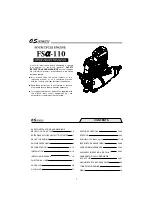
27
BIODIESEL (FAME)
Use of biodiesel
IMPORTANT !
For engines with SCR systems, a maximum of 10% mix-
ture of biodiesel should be used.
Scania uses the term biodiesel to refer to a renewable
diesel made from greases or oils and methanol. The
biodiesel should conform to the requirements of Euro-
pean standard EN 14214 or Brazilian standard ANP-45.
For biodiesel in accordance with EN 14214 or ANP-45,
the generic term FAME is frequently used.
Normal diesel in accordance with EN 590 can contain
up to 7% biodiesel from the diesel supplier. There are
grades of diesel that comply with EN 590 but contain a
higher mixture of biodiesel.
Scania approves up to a 10% mixture of biodiesel for all
engines.
For PDE engines, Scania approves the use of up to 100%
biodiesel in accordance with EN 14214 or ANP-45. How
-
ever, this does not apply to engines with an SCR system,
for which only a 10% mixture is permitted.
MAINTENANCE INTERVAL
IMPORTANT !
Make sure that maintenance intervals are different when
operating on diesel or biodiesel.
With a greater mixture of biodiesel than 10%, the renew-
al intervals for the following are halved:
• Fuel filter.
• Oil filter.
• Engine oil.
The viscosity grade of the engine oil should be xW-40.
xW-30 grade oils are unsuitable due to the fuel dilution
effect.
Check the engine oil level regularly. If the oil level ex-
ceeds the maximum level, the oil must be changed.
Check the cause if the oil level exceeds the maximum
level and contact your nearest Nanni representative if
you suspect a fault, or in case of doubt.
S03
FLUIDS
STORAGE OF BIODIESEL
IMPORTANT !
Biodiesel must not be stored for more than 6 months.
Biodiesel has a maximum storage life of
6 months from the date of production to the expiry date.
The fuel is affected by light, temperature, water, etc. dur-
ing storage, which affects the fuel characteristics and
durability.
Biodiesel also has lower stability against oxidation than
diesel. This can result in a thickening of the fuel and
blocking of parts of the fuel system, e.g. the fuel filter.
Bacterial growth can occur when fuel is stored in tanks
under unfavourable conditions. Avoid storage in barrels
or auxiliary tanks, except when fuel turnover rates are
high. Check tank cleanliness whenever refuelling takes
place.
If the engine has been refuelled with biodiesel, and is
stationary for a long period, condensation water can
form in the fuel tank resulting in bacterial growth.
See also the Preservative fuel paragraph in the following
pages.
HVO
HVO is a synthetic diesel which is manufactured through
the hydrogenation of plants and animal fats. To the user,
HVO is reminiscent of diesel in accordance with EN590,
apart from HVO having a somewhat lower density. Sca
-
nia approves the use of up to 100% HVO for all engines
in accordance with the European standard EN 15940.
GTL
GTL is a synthetic fuel that is often refined from natural
gas. To the user, GTL is reminiscent of diesel in accord-
ance with EN590, apart from GTL having a somewhat
lower density and less odour. Scania approves the use
of up to 100% GTL in accordance with the European
standard EN 15940.
Содержание N16.900 CR3
Страница 2: ......
Страница 4: ......
Страница 34: ...34 S05 COMPONENTS ENGINE VIEWS N16 CR3 ...
Страница 35: ...35 NOTES ...
Страница 48: ...48 S06 INSTRUMENTATION SYSTEM LAYOUT INCLUDING OPTIONS ...
Страница 118: ......
















































